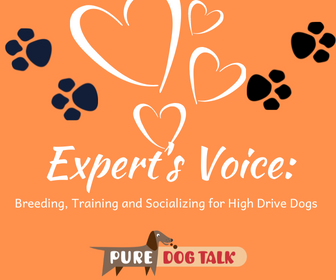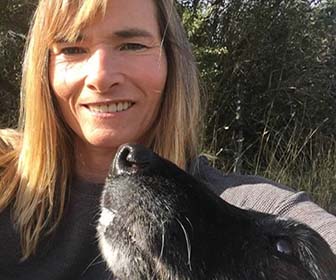508 – Breeding, Training and Socializing Decisions for High Drive Dogs
Breeding, Training and Socializing Decisions for High Drive Dogs
Denise Fenzi and host Laura Reeves take a deep dive into the breeding, training and socializing decisions we make with high drive dogs. Are we removing “hard” dogs from our gene pool in favor of “twitchy,” flashy high arousal dogs?
“So, drive always requires arousal,” Fenzi noted. “Arousal does not require drive. That is a good base. I like to recognize that and to recognize that arousal can hinder the dog’s ability to see the world clearly, so your socialization goes to hell, as the dog is so busy moving, they’re not actually taking it in.
“Then, when they’re three, they take it in and that’s a problem. ‘Cause for the first time they just saw a garbage can on wheels. It’s been there the whole time, they just never slowed down enough to see it. In training, we actually perpetuate that. What we do with these high arousal dogs is we work them. We get the toys and play, we focus on really early and they go for it, because they’re high arousal dogs, they need something to attach it to and so we actually undermine our socialization.”
This in-depth, experience-based discussion between industry leaders asks important questions and offers insight for breeders who want to learn more about breeding high drive dogs in any performance venue.
Laura Reeves: “I think it’s so important, when we talk about these things from the perspective of purebred dogs and doing events and doing sports and doing show, if that’s part of our consideration, all of those things it all is breed specific.”
Denise Fenzi: Absolutely
Laura Reeves: Starting at that instinct piece that you were talking about, the instinct has to be there and then you layer on all the rest of it.
Denise Fenzi: Yes. And then you’ve got your focus and all kinds of other things that are going to come into play. Even the definition. How do you define drive? My definition is “stays in the game under adversity.” So, it doesn’t matter what your game is and it doesn’t matter what the adversity is. It could be weather, could be bad training. There are dogs who are out there in crappy weather, under crappy training and I mean I don’t know how they do it, but they figure out what the trainer wants and they just flat on go forward. To me that’s drive … with a good dose of hardness
Defining and understanding drive, considering the inheritance patterns of drive and arousal, addressing anxiety as a corollary, Denise and Laura dig in to the hard topics, the difficult conversations and the implications of our breeding decisions.
Listen to part one here.
507 — Denise Fenzi on “Drive” vs “Arousal” in Dogs
Denise Fenzi on “Drive” vs “Arousal” in Dogs
Denise Fenzi, Founder of the famous Fenzi Dog Sport Academy, joins host Laura Reeves for Part 1 of this powerful and thoughtful conversation about what drives our dogs to the behaviors we see.
Denise and Laura discuss the difference between drive and arousal, and how that impacts on our dogs, particularly performance dogs, and some of the things that we as breeders need to consider when making breeding decisions.
“In the make-up of the dog, you’ve got the very bottom level,” Fenzi said. “Let’s call that instinct. Those are things that the dog does to stay alive. If you have a highly predatory dog and a rabbit goes by, the dog doesn’t think about what it’s going to do it goes. That’s the very bottom basic level. I will tell you that, in my opinion, this is where drives are rooted. So, the very bottom level is instinct in my opinion it is the hardest to change.
“Instinctually driven behaviors are very resistant to change. This is both good and bad because this is why your hunting dog goes out for an hour and does the thing. It’s painful, it’s hot, it’s tired, it’s cranky and it just keeps doing it and maybe it doesn’t even know why it keeps doing it, it just does the thing.
“One level up is the emotional level. That is where you have fear. Anxiety is linked to fear, it’s irrational fear, like you don’t even know why you’re afraid you’re just feeling anxious. You have happiness, you have anger, you have joy, you have caretaking for your young. So let’s call that the emotional level. Arousal can come from either one of those places… the bottom level the predatory drive instinctual base level, or it can come from the emotional level.
“Drive has a focus. Arousal is scattered movement. Focus sort of ties it altogether. If you have drive for a thing then you have to have focus or you just went out of drive. Now you’re looking at something else. Arousal gets complicated, because arousal can look like drive. (But) a dog can be in arousal and have no drive whatsoever.”
Listen to the whole show above to hear more.
Fenzi has titled dogs in obedience (AKC and UKC), tracking (AKC and schutzhund), schutzhund (USA), mondioring (MRSA), herding (AKC), conformation (AKC), and agility (AKC). She has two AKC obedience champions, perfect scores in both schutzhund and Mondio ringsport obedience, and is well known for her flashy and precise obedience work.
While a successful competitor, Fenzi’s real passion lies in training dogs and solving the problems that her own dogs and her students’ dogs present. She is a recognized expert in developing drive, motivation, and focus in competition dogs, and is known internationally as an engaging speaker and an expert in no-force training for sport dogs. She has consistently demonstrated the ability to train and compete with dogs using motivational methods in sports where compulsion is the norm.


